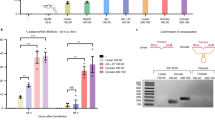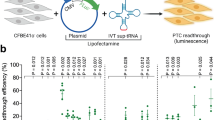Abstract
The ability of ribozymes to cleave specific transcripts and repair defective RNAs in the test tube has engendered speculation about their potential clinical utility. Therapeutic development has been hindered by an inability to evaluate and optimize the efficiency of RNA catalysis in vivo. We describe an experimental system that has allowed us to assess and enhance the efficiency with which a trans-splicing group I ribozyme reacts with a targeted RNA in mammalian cells. These results demonstrate that the ribozyme can convert up to 49% of a specific substrate RNA to product in the cellular environment and that the efficiency of this reaction is apparently a function of the ribozyme's ability to find and bind to the substrate RNA in the cell. These observations suggest that trans-splicing ribozymes may become useful reagents to repair a therapeutically significant fraction of mutant RNAs associated with a variety of genetic diseases.
This is a preview of subscription content, access via your institution
Access options
Subscribe to this journal
Receive 12 print issues and online access
$209.00 per year
only $17.42 per issue
Buy this article
- Purchase on Springer Link
- Instant access to full article PDF
Prices may be subject to local taxes which are calculated during checkout
Similar content being viewed by others
References
Herschlag, D. and Cech, T.R. 1990 Catalysis of RNA cleavage by the Tetrahymena thermophila ribozyme. 1. Kinetic description of the reaction of an RNA substrate complementary to the active site. Biochemistry 29: 10159–10171.
Hertel, K.J., Herschlag, D. and Uhlenbeck, O.C. 1994. A kinetic and thermodynamic framework for the hammerhead ribozyme reaction. Biochemistry 33: 3374–3385.
Pyle, A.M. and Green, J.B. 1994. Building a kinetic framework for the group II intron ribozyme activity: quantitation of interdomain binding and reaction rate. Biochemistry 33: 2716–2725.
Beebe, J.A. and Fierke, C.A. 1994. A kinetic mechanism for cleavage of precursor tRNA(Asp) catalyzed by the RNA component of Bacillus subtilis ribonuclease R. Biochemistry 33: 10294–10304.
Zaug, A.J., Been, M.D. and Cech, T.R., 1986. Tetrahymena ribozyme acts like an RNA restriction endonuclease. Nature 324: 429–433
Uhlenbeck, O.C. 1986. A small catalytic oligoribonucleotide. Nature 328: 596–600.
Haseloff, J. and Gerlach, W.L. 1988. Simple RNA enzymes with new and highly specific endoribonuclease activities.Nature 334: 585–591.
Feldstein, P.A., Buzayan, J.M. and Bruening, G. 1990. Two sequences participating in the autolytic processing of satellite tobacco ringspot virus complementary RNA. Gene 3: 53–61.
Hampel, A., Tritz, R., Hicks, M. and Cruz, P. 1990. Hairpin' catalytic RNA model: evidence for helices and sequence requirement for substrate RNA. Nucl.Acids Res. 18: 299–304.
Chowrira, B.M. and Burke, J.M. 1991. Binding and cleavage of nucleic acids by the hairpin ribozyme. Biochemistry 30: 8518–8522.
Forester, A.C. and Altman, S. 1990. External guide sequence for an RNA enzyme. Science 249: 783–786.
Perrotta, A.T. and Been, M.D. 1992. Cleavage of oligoribonucleotides by a ribozyme derived from the hepatitis delta virus RNA sequence. Biochemistry 31: 16–21.
Inoue, T., Sullivan, F.X. and Cech, T.R. 1985. Intermotecular exon ligation of the rRNA precursor of Tetrahymena: oligonucleotides can function as 5' exons. Cell 43: 431–437.
Been, M.D. and Cech, T.R. 1986. One binding site determines sequence specificity of Tetrahymena pre-rRNA self-splicing, trans-splicing, and RNA enzyme activity. Cell 47: 207–216.
Cech, T.R. 1988. Ribozymes and their medical implications. JAMA. 260: 3030–3034.
Rossi, J.J 1992. Ribozymes. Curr. Opin. Biotechnol. 3: 3–7.
Yu, M., Poeschla, E. and Wong-Staal, F. 1994. Progress towards gene therapy for HIV infection. Gene Ther. 1: 13–26.
Sullenger, B.A. 1995. Revising messages traveling along the cellular information superhighway. Chem. & Biol. 2: 249–253.
Cech, T.R. 1987. The chemistry of self splicing RNA and RNA enzymes. Science 236: 1532–1539.
Cech, T.R. 1990. Self-splicing of group I introns. Ann. Rev. Biochem. 59: 543–568.
Jones, J.T., Lee, S.-W. and Sullenger, B.A. 1996. Tagging ribozyme reaction sites to follow trans-splicing in mammalian cells. Nature Medicine 2: 643–648.
Zaug, A.J., Grosshans, C.A. and Cech, T.R. 1988. Sequence-specific endoribonuclease activity of the Tetrahymena ribozyme: enhance cleavage of certain oligonucleotide substrates that form mismatched ribozyme-substrate complexes. Biochemistry 27: 8924–8931.
Gilliland, G., Perrin, S. and Bunn, H.F. 1990. Competitve PCR for quantitation of mRNA, in PCR protocols: A guide to methods and applications. Innis, MA, Gelfand, D.H., Sninsky, J.J., and Whit, T.J. (eds.) Academic Press, San Diego, CA.
Sullenger, B.A. and Cech, T.R. 1994. Ribozyme-mediated repair of defective mRNA by targeted trans-splicing. Nature 371: 619–622.
Elroy-Stein, O. and Moss, B. 1990. Cytoplasmic expression system based on constitutive synthesis of bacteriophage T7 RNA polymerase in mammalian cells. Proc. Natl. Acad. Sci. U.S.A. 87: 6743–6747.
Sullenger, B.A. and Cech, T.R. 1993. Tethering ribozymes to a retroviral packaging signal for destruction of viral RNA. Science 202: 1566–1569.
Yarus, M.A. 1988. A specific amino acid binding site composed of RNA. Science 240: 1751–1758.
Yarus, M. 1989. Specificity of arginine binding by the Tetrahymena intron. Biochemistry 28: 980–995.
Murphy, F.L. and Cech, T.R. 1989. Alteration of substrate specificity for the endoribonucleolytic cleavage of RNA by the Tetrahymena ribozyme. Proc. Natl. Acad. Sci. USA 86: 9218–9222.
Author information
Authors and Affiliations
Rights and permissions
About this article
Cite this article
Jones, J., Sullenger, B. Evaluating and enhancing ribozyme reaction efficiency in mammalian cells. Nat Biotechnol 15, 902–905 (1997). https://doi.org/10.1038/nbt0997-902
Received:
Accepted:
Issue Date:
DOI: https://doi.org/10.1038/nbt0997-902
This article is cited by
-
Targeted gene correction by small single-stranded oligonucleotides in mammalian cells
Gene Therapy (2001)
-
RNA repair as a novel to genetic therapy
Gene Therapy (1999)



